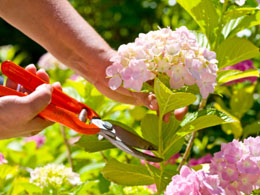Along with the right type of soil, the right amount of water and the right place to grow a plant, you need to prune it properly to ensure it grows in a healthy manner. Read on to learn how to prune geraniums.
 Observe yon sweet geranium flower.
Observe yon sweet geranium flower.
How straight upon its stalk it stands,
And tempts our violating hands,
Whilst the soft bud, as yet outspread,
Hangs down its pale declining head.
Yet soon as it is ripe to blow,
the stems shall rise, the head shall glow. ~ "THE GERANIUM" by Richard Brinsley Sheridan
There's nothing like a brightly blooming bed of flowers to add color to one's garden. If flowers had personalities, then geraniums would be the friendliest, with their vibrant colored petals and their blooming presence. This flowering plant, also known as cranesbills, is actually a genus of 422 species. They bloom throughout the year and have a 5 petaled flower, in colors or red, white, blue, pink and purple. Unlike most flowering plants (some may need an entourage to look after them), geraniums make for hardy, long-lived plants that require minimal care during the winter months and provide fresh blooms for your garden and house, throughout the year. One aspect of caring for plants, is their trimming or pruning. Learn how to prune geraniums properly, with the following tips.
Pruning Geraniums
The act of pruning, like getting a haircut, encourages new and healthy growth. Pruning geraniums encourages new and vibrant growth from the plant, so there are more flowers, distributed lushly amongst the plant and growing healthily and fully. The appeal to geraniums are their rich, vibrant blooms. But without pruning, you could end up with a flowerless plant. Keep in mind that there is pruning and there's hacking off the plant, which can be detrimental to its growth. You must know which parts should be cut off and how. The process of pruning consists of 3 main parts:
The Right Time
Unlike humans, plants can't tell you when they need a haircut. As a gardener, some key signs that your geraniums need pruning are:
- When the plant starts to look very thin or sparse
- Dead or rotting parts like brown leaves, dead blooms etc., appear on the plant
- Tendency to loll or sprawl on the ground, due to droopy stem growth
- When a compound flower head (stem with more than 1 bloom on it) starts to look faded and old
- When your plant grows long and spindly with no blooms
Geraniums are easy to maintain but once in a while, if they start to exhibit any of the above signs, it is necessary to pinch back new growth on the stems. It is recommended to prune your geraniums intensely once a year. This pruning should take place during the winter season, as this is a time when the plant goes dormant and does not grow. Pruning at this time encourages fresh healthy blooms in spring.
What Should be Pruned?
The tip of the stem, from where new plant growths occur, should be pinched back from time to time. This forces the plant to branch out and grow more blooms. Pinching back means you use your finger nails or fingers, to lightly nip off the growth at the end of the stem. Try to pinch off the stem as close to a leaf node as possible. Do not pull the plant in an attempt to pinch. You can use a small but sharp pair of scissors to pinch the buds instead of your fingers. Any dead or dry blooms on the plant, which are faded and old, should be snipped off at the stalk. This can be done at any time of the plant's growth. Any signs of disease or an insect infestation, means the plant should be pruned of its flowers immediately. During the annual pruning, any dead or old parts of the plant should be pruned, along with some stems and blooms.
How to Prune Geraniums
The following are some steps on how to prune your geraniums intensely:
- Use your fingers for pinching off new growths and use pruning shears for snipping off dead blooms and dried out or damaged stems.
- Snip off dead flowers from their stalk or elbow (where they are joined to a main stem). Remove any faded and brown leaves and if any stems are broken, remove them as well.
- Pull out weeds and other small plants growing unwanted, in your germanium plant bed. Examine your plant's leaves for signs of rot or a fungal infection. Remove any insects on the plant.
- Cut off all the stems from the plant, leaving only 3-4 stems with blooms. This pruning may seem very harsh but geraniums are enthusiastic growers and will soon grow full blooms with a vengeance.
- When cutting branches and stems, make sure your shears are sharp. Cut at an angle of 45°. This is a good pruning practice.
- Cut down the plant's length, such that it is 4-6 inches above the soil. The plant should be pruned to 1/3 of its total growth. Using a gardening fork or rake, gently shift the soil in the geranium bed.
In conclusion, geraniums are easy to look after, delightful blooming bundles, that are a welcome addition of color to any garden. With the right care and maintenance, including pruning and trimming, they can be the highlight plant of a novice gardener or a carefully-styled masterpiece for an old-timer.






 Observe yon sweet geranium flower.
Observe yon sweet geranium flower.